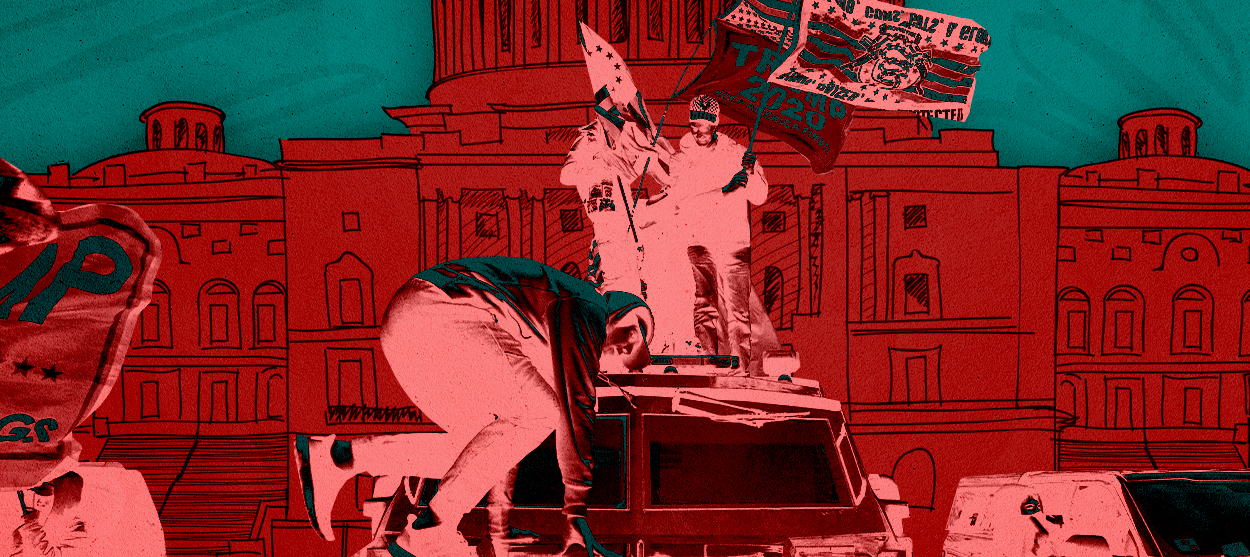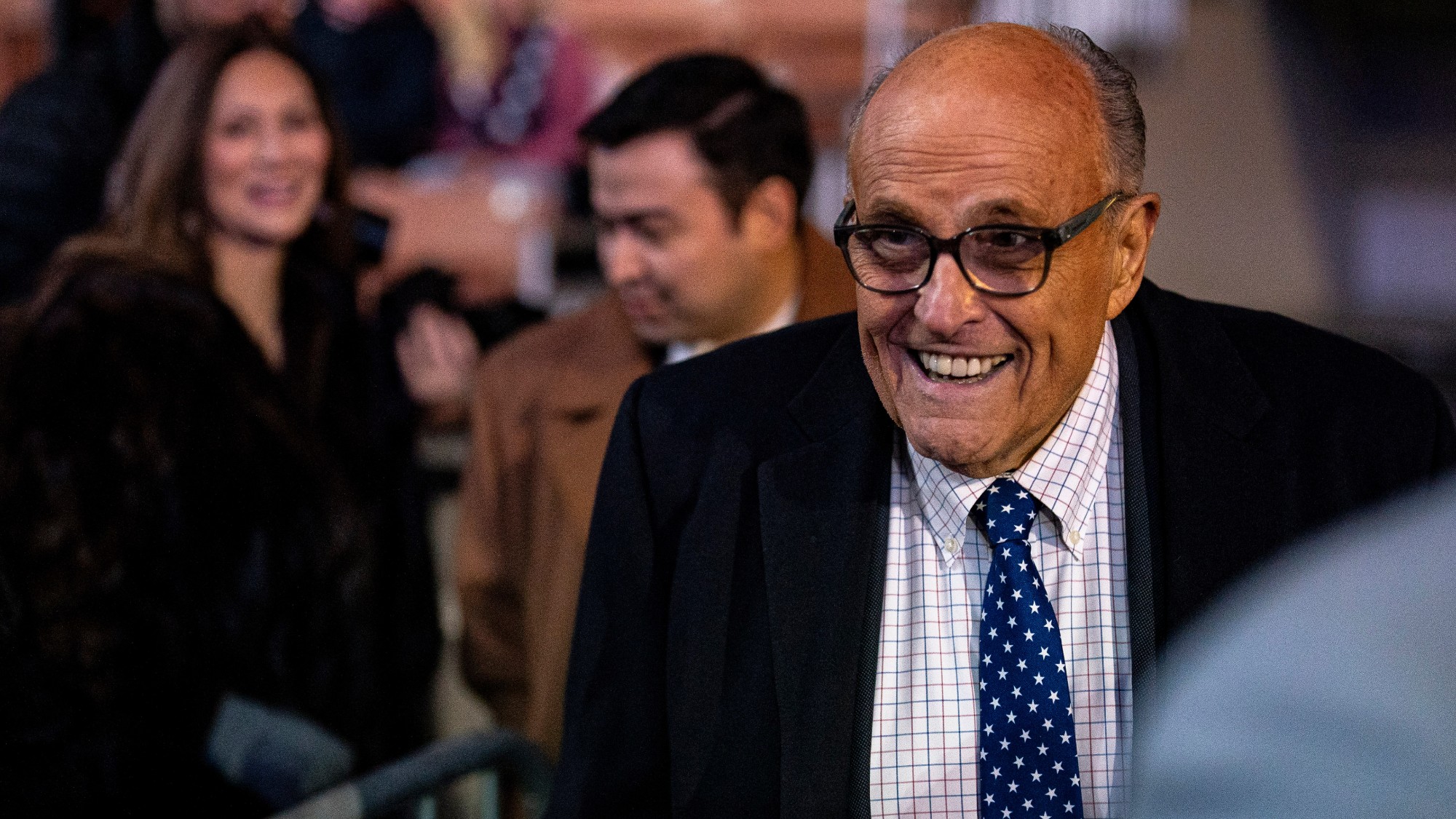Who were the Capitol rioters?
Why class alone is a poor explanation of the mob's makeup


President Trump "was annoyed by the violent siege on the Capitol Wednesday — which left several dead — because it looked 'low class,'" reported New York magazine's Olivia Nuzzi last week, citing an unnamed Trump adviser.
Was he right? Trawling for class analyses of the rioters this past week, I've found nearly every possible variation: They were underclass. They were middle class. They were upper middle class. They were unemployed. They were small business owners. They were the deceived proletariat. They were the knowing petty bourgeois.
These analyses can't all be true — at least, not in their typical presentation as a comprehensive story of the crowd. So who were the Capitol rioters? (Polling already shows they are not simply a representative sample of the average, much-studied Trump voter.)
The Week
Escape your echo chamber. Get the facts behind the news, plus analysis from multiple perspectives.

Sign up for The Week's Free Newsletters
From our morning news briefing to a weekly Good News Newsletter, get the best of The Week delivered directly to your inbox.
From our morning news briefing to a weekly Good News Newsletter, get the best of The Week delivered directly to your inbox.
The Atlantic's Caitlin Flanagan, though no friend to Trump, agreed with his description. "Here they were, a coalition of the willing: deadbeat dads, YouPorn enthusiasts, slow students, and MMA fans," she wrote in a piece skewering the "worst revolution ever." "[T]hey had pulled into the swamp with bellies full of beer and Sausage McMuffins, maybe a little high on Adderall, ready to get it done," Flanagan continued, mocking the crowd as bigoted, ignorant "dumbasses."
Not so, said Flanagan's Atlantic colleague, Adam Serwer. "They were business owners, CEOs, state legislators, police officers, active and retired service members, real-estate brokers, stay-at-home dads," he wrote. While "any crowd that size is bound to include people who are struggling financially," Serwer said, the bulk "weren't 'low class.' They were respectable," rioting because "they believed they had been unjustly stripped of their inviolable right to rule."
Politico's Jack Shafer similarly thought the "Capitol insurrectionists represent a bigger slice of white America than just the low-class knuckle-draggers who rolled in from the sticks on Donald Trump's command." He argued we'd be unwise to ignore that this is a rising "national rebellion" manned by middle- and professional-class "people who better resemble our kin and neighbors than they do the so-called barbarians from the boondocks."
Meanwhile, Columbia University professor Jeffrey D. Sachs said the rioters were members of the white underclass manipulated by the white elite. The Philadelphia Inquirer's Will Bunch described them as "upper middle class" fascists who "came from lush-green suburbs all across this land, flying business class on Delta or United and staying in four-star hotels with three-martini lobby bars." At The New Republic, Katie McDonough cited a recent analysis of the 2016 election which found "support for Trump was strongest among the locally rich — that is, white voters with incomes that are high for their area, though not necessarily for the country as a whole." The crowd in Washington wasn't working-class, she said, even if not "every guy who rushed a police barricade was a small-business owner."
A free daily email with the biggest news stories of the day – and the best features from TheWeek.com
I think I can make out a sort of synthesis of this discord: Eww, but they actually do have some money. They are distasteful and deluded, but not truly disadvantaged, a combination which makes them totally unsympathetic to many critics.
That judgment is mostly aesthetic and moral. It doesn't settle the competing class narratives — perhaps because, though certainly worth attention, class as traditionally measured by income, employment, and wealth has increasingly limited use as a solitary point of analysis in American politics. (If I had to guess, I'd say there's some truth in each of the takes above: As anecdotal accounts from news reports and arrest records show, there were many middle-class people who stormed the Capitol. There were also unemployed people and people in generational poverty alongside doctors, lawyers, elected officials, and at least one Olympic athlete.) If we want to know who the rioters were, we need to look at more than their money.
The demographic point to which many have turned next is race, an obvious choice given Trump's involvement. It's also, conveniently, identifiable in any photo: The crowd that overran the Capitol was overwhelmingly white, perhaps even more than Trump voters generally.
But we can and should go beyond that. What about geography? Not a simple urban vs. rural or coastal supercity vs. flyover states breakdown, though that's part of it. I'm interested in a finer-grained analysis of whether the rioters come from places that are thriving, however that's shaped and scaled for each locale.
Do they come from places where there is realistic, local hope for a better future in their lifetimes? Are they from "back-row America"? Are their hometown populations and median incomes growing or shrinking? President-elect Joe Biden won in the counties representing 70 percent of the national economy, so the answer for many is probably "shrinking." McDonough's mention of the "local rich" gets at an important piece here: Someone who runs the last surviving small business in an old coal town — to traffic in a classic Trump supporter stereotype — may be personally doing fine (upper middle class, even!) and yet daily facing the reality that his community is hopeless.
Next is religion, because the religious element of the riot was almost as visible as the whiteness: It was Christian nationalism, resourced from white evangelicalism, prosperity gospel hucksters, and the charismatic movement's characteristic confidence in individual ability to hear from God. (Little of that is "respectable," by the way. "Holy rollers" is not a term of respect, as religiosity plummets it becomes more suspect.) "To me, God and country are tied," explained a woman who broke into the House speaker's office. "To me they're one and the same."
Last is education. The diploma divide is real and has widened remarkably over the last two decades, especially among white people. The Democratic Party is increasingly the party of those with college degrees and the GOP the party of those without. Of course, to be a college graduate is no guarantee of wealth. It's not even a certain ticket to the middle class, particularly for grads saddled with enormous student debt and/or under- or unemployment. But it does provide a social perch from which to find the Capitol rioters not merely wrong, deceived, dangerous, etc. but also dumb, outmoded, and tacky. Eww.
This is why I think asking how much money the rioters make is so inadequate on its own. Old models of class — where income neatly corresponds to education, the middle class values being considerate, the working class values order, and so on — are clearly lacking as totalized explanations of what happened in Washington last week.
We need to ask more and more varied questions to know who the Capitol rioters are. And we do need to know who they are, whether we aim to sympathize with, engage, or understand them — or merely to strategize for what they might do next.
Bonnie Kristian was a deputy editor and acting editor-in-chief of TheWeek.com. She is a columnist at Christianity Today and author of Untrustworthy: The Knowledge Crisis Breaking Our Brains, Polluting Our Politics, and Corrupting Christian Community (forthcoming 2022) and A Flexible Faith: Rethinking What It Means to Follow Jesus Today (2018). Her writing has also appeared at Time Magazine, CNN, USA Today, Newsweek, the Los Angeles Times, and The American Conservative, among other outlets.
-
 A running list of the US government figures Donald Trump has pardoned
A running list of the US government figures Donald Trump has pardonedin depth Clearing the slate for his favorite elected officials
-
 Ski town strikers fight rising cost of living
Ski town strikers fight rising cost of livingThe Explainer Telluride is the latest ski resort experiencing an instructor strike
-
 ‘Space is one of the few areas of bipartisan agreement in Washington’
‘Space is one of the few areas of bipartisan agreement in Washington’Instant Opinion Opinion, comment and editorials of the day
-
 Bari Weiss’ ‘60 Minutes’ scandal is about more than one report
Bari Weiss’ ‘60 Minutes’ scandal is about more than one reportIN THE SPOTLIGHT By blocking an approved segment on a controversial prison holding US deportees in El Salvador, the editor-in-chief of CBS News has become the main story
-
 Has Zohran Mamdani shown the Democrats how to win again?
Has Zohran Mamdani shown the Democrats how to win again?Today’s Big Question New York City mayoral election touted as victory for left-wing populists but moderate centrist wins elsewhere present more complex path for Democratic Party
-
 Millions turn out for anti-Trump ‘No Kings’ rallies
Millions turn out for anti-Trump ‘No Kings’ ralliesSpeed Read An estimated 7 million people participated, 2 million more than at the first ‘No Kings’ protest in June
-
 Ghislaine Maxwell: angling for a Trump pardon
Ghislaine Maxwell: angling for a Trump pardonTalking Point Convicted sex trafficker's testimony could shed new light on president's links to Jeffrey Epstein
-
 The last words and final moments of 40 presidents
The last words and final moments of 40 presidentsThe Explainer Some are eloquent quotes worthy of the holders of the highest office in the nation, and others... aren't
-
 The JFK files: the truth at last?
The JFK files: the truth at last?In The Spotlight More than 64,000 previously classified documents relating the 1963 assassination of John F. Kennedy have been released by the Trump administration
-
 'Seriously, not literally': how should the world take Donald Trump?
'Seriously, not literally': how should the world take Donald Trump?Today's big question White House rhetoric and reality look likely to become increasingly blurred
-
 Will Trump's 'madman' strategy pay off?
Will Trump's 'madman' strategy pay off?Today's Big Question Incoming US president likes to seem unpredictable but, this time round, world leaders could be wise to his playbook
